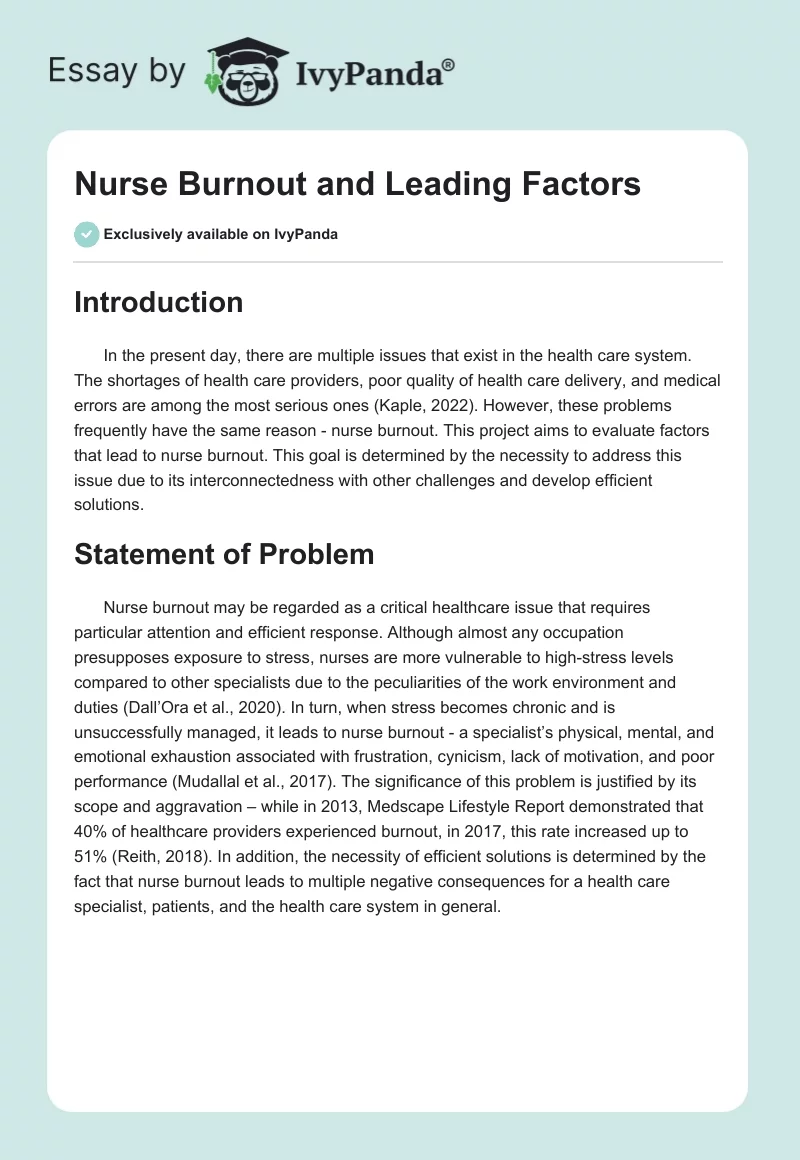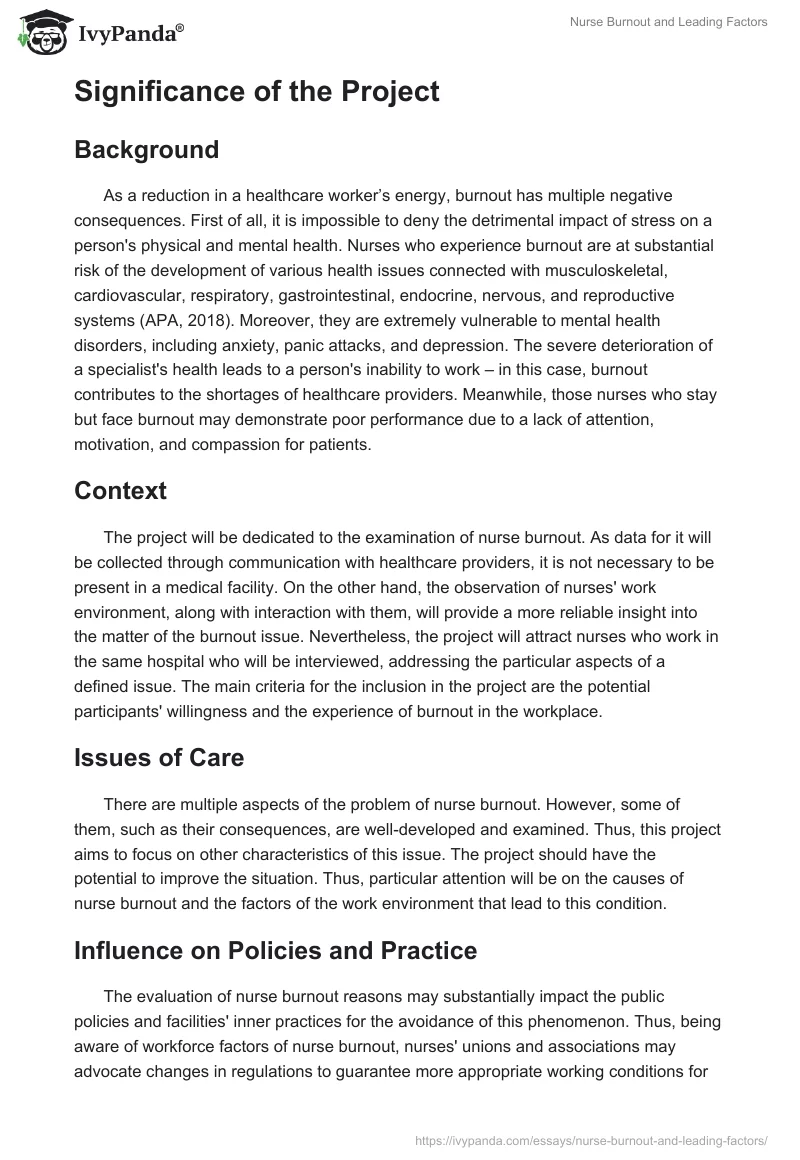Introduction
In the present day, there are multiple issues that exist in the health care system. The shortages of health care providers, poor quality of health care delivery, and medical errors are among the most serious ones (Kaple, 2022). However, these problems frequently have the same reason – nurse burnout. This project aims to evaluate factors that lead to nurse burnout. This goal is determined by the necessity to address this issue due to its interconnectedness with other challenges and develop efficient solutions.
Statement of Problem
Nurse burnout may be regarded as a critical healthcare issue that requires particular attention and efficient response. Although almost any occupation presupposes exposure to stress, nurses are more vulnerable to high-stress levels compared to other specialists due to the peculiarities of the work environment and duties (Dall’Ora et al., 2020). In turn, when stress becomes chronic and is unsuccessfully managed, it leads to nurse burnout – a specialist’s physical, mental, and emotional exhaustion associated with frustration, cynicism, lack of motivation, and poor performance (Mudallal et al., 2017). The significance of this problem is justified by its scope and aggravation – while in 2013, Medscape Lifestyle Report demonstrated that 40% of healthcare providers experienced burnout, in 2017, this rate increased up to 51% (Reith, 2018). In addition, the necessity of efficient solutions is determined by the fact that nurse burnout leads to multiple negative consequences for a health care specialist, patients, and the health care system in general.
Significance of the Project
Background
As a reduction in a healthcare worker’s energy, burnout has multiple negative consequences. First of all, it is impossible to deny the detrimental impact of stress on a person’s physical and mental health. Nurses who experience burnout are at substantial risk of the development of various health issues connected with musculoskeletal, cardiovascular, respiratory, gastrointestinal, endocrine, nervous, and reproductive systems (APA, 2018). Moreover, they are extremely vulnerable to mental health disorders, including anxiety, panic attacks, and depression. The severe deterioration of a specialist’s health leads to a person’s inability to work – in this case, burnout contributes to the shortages of healthcare providers. Meanwhile, those nurses who stay but face burnout may demonstrate poor performance due to a lack of attention, motivation, and compassion for patients.
Context
The project will be dedicated to the examination of nurse burnout. As data for it will be collected through communication with healthcare providers, it is not necessary to be present in a medical facility. On the other hand, the observation of nurses’ work environment, along with interaction with them, will provide a more reliable insight into the matter of the burnout issue. Nevertheless, the project will attract nurses who work in the same hospital who will be interviewed, addressing the particular aspects of a defined issue. The main criteria for the inclusion in the project are the potential participants’ willingness and the experience of burnout in the workplace.
Issues of Care
There are multiple aspects of the problem of nurse burnout. However, some of them, such as their consequences, are well-developed and examined. Thus, this project aims to focus on other characteristics of this issue. The project should have the potential to improve the situation. Thus, particular attention will be on the causes of nurse burnout and the factors of the work environment that lead to this condition.
Influence on Policies and Practice
The evaluation of nurse burnout reasons may substantially impact the public policies and facilities’ inner practices for the avoidance of this phenomenon. Thus, being aware of workforce factors of nurse burnout, nurses’ unions and associations may advocate changes in regulations to guarantee more appropriate working conditions for specialists. In addition, the authorities of medical facilities will consider the review of their inner policies for the minimization of employees’ burden that causes the depletion of their energy. Moreover, on the basis of the results, special training for nurses may be organized. Due to them, healthcare workers will learn to prevent and cope with burnout.
Next Steps
In general, the results of this project will be beneficial in two major ways. First of all, they may be practically applied to prevent nurse burnout and mitigate its consequences. As previously mentioned, data collected from nurses and subsequently analyzed by researchers may be used by authorities to develop a framework within which particular actions for the improvement of nurses’ working conditions will be taken. Moreover, the project’s outcomes may provide a basis for future research. For instance, it may be the evaluation of the impact of nurses’ personal characteristics on resilience and the mitigation of stress.
Benefits from the Project
First of all, this project will be beneficial for healthcare educators. On the basis of its results, they will be able to create efficient programs to help healthcare providers to avoid burnout. Therefore, the project will be beneficial for nurses and other medical staff. When actions are taken, they will receive clear algorithms of actions to defend themselves from burnout. Finally, the project will benefit nurse leaders as they will have an opportunity to enhance their skills to support nurses who face burnout.
Conclusion
The project will address the problem of nurse burnout and its factors in particular. As a serious stress-related condition, burnout leads to multiple negative consequences. It negatively impacts nurses’ emotional and physical health, patients’ outcomes, and the healthcare system’s performance (Mudallal et al., 2017). In turn, examining burnout’s causes may initiate significant changes in policies and practices to reduce this issue. While this project will have practical benefits, it may also contribute to future research.
References
APA. (2018). Stress affects on the body.
Dall’Ora, C., Ball, J., Reinius, M., & Griffiths, P. (2020). Burnout in nursing: A theoretical review.Human Resources for Health, 18(1), 1-17.
Kaple, T. (2022). Top tips from nurses on dealing with burnout. Nurse Journal.
Mudallal, R. H., Othman, W. A. M., & Al Hassan, N. F. (2017). Nurses’ burnout: The influence of leader empowering behaviors, work conditions, and demographic traits.INQUIRY: The Journal of Health Care Organization, Provision, and Financing, 54, 1-10.
Reith, T. P. (2018). Burnout in United States healthcare professionals: A narrative review.Cureus, 10(12), 1-9.


